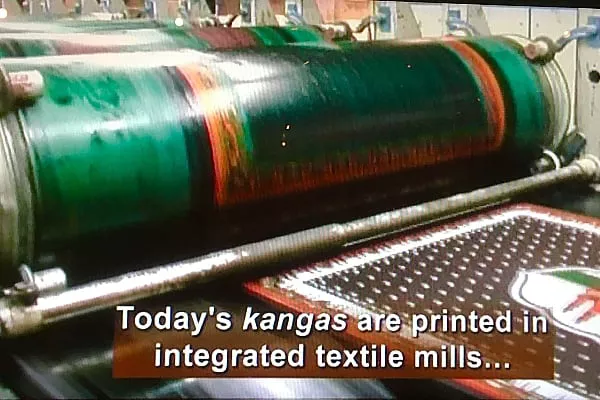Kanga is a type of traditional African clothing that was first introduced to our founder, Sian, during her initial trip to Tanzania in 2013. Sian volunteered for a youth charity and lived with a local family for 3 months.
Sian’s Tanzanian ‘Mama’ (Mum in Swahili) gave a pair of kangas to Sian as a welcome gift on her first day of arrival. Kangas play an important role in modern Swahili culture and Sian quickly learnt how to wear and use them daily.
Since then her collection of kangas has grown. Read on to learn more about kangas including their origins, how they are used and worn today and their unique meanings.
Kanga (also called ‘Leso’ in Kenya) is a rectangular shaped, 100% cotton, printed cloth with a brightly coloured decorative border around the outside and includes a Swahili proverb.

A kanga ‘Commemorating the life and mourning the death of Julius Nyerere, 1922-1999, the father of Independent Tanzania’ (The British Museum, London, UK)
Kanga is usually bought in a pair (2 pieces joined together) and need to be cut and sewn along the raw edge to separate them before being worn. Kanga is extremely popular in East Africa and is worn daily by millions of women.
Kangas are very popular gifts, especially for birthdays and weddings. If you are a guest at somebody’s house then they may present you with your own kanga, which is a sign of friendship. They say that every woman should own a thousand kangas!

Tanzanian kanga designs displayed at The British Museum, London, UK
Kanga is a much lighter and thinner cloth than Kitenge (also known as African print fabric or ‘ankara fabric‘ in West Africa). Kitenge is usually bought in continuous 3 or 6 pieces and is more popular for making clothing, curtains, cushions and bedding.
Kangas have existed in East Africa since the mid 19th century. In the 1870s Muslim Women in Zanzibar and Mombasa, Kenya, bought printed bandanas, imported by Portuguese traders. They sewed 6 of these colourful bandanas together to make a unique piece of cloth, which they could wear modestly.
Traders along the Swahili coast quickly reacted to this emerging trend and arranged for designs to be hand-stamped, using carved wooden blocks, onto a single piece of locally woven cloth instead of lots of smaller squares sewn together.

Women in Zanzibar wearing kangas whilst bartering for fish at the market
The cloth is named after the Swahili word for the spotted black and white guinea fowl. This is due to the fact that the first printed cloths used a similar print to that found on the guinea fowl, which was very popular at the time.
Today, there are a large number of different Kanga designs available to purchase in the markets of East Africa. Kangas were commonly produced in India, China, Europe (UK) and Japan until the 1960s when factories were set up in Kenya and Tanzania. They now use large, industrial rotary screen-printing machines and can produce large quantities in bulk.
The design is first created by hand using a fine paintbrush. It is then transferred onto a computer and the different layers of the design are printed onto see-through, plastic screens. These screens are then transferred onto the rollers for printing. Each roller will print a different colour of the design directly onto the cloth.

A rotary screen-printing machine (Credit: The British Museum)

Large scale Kanga production at an integrated textile mill (Credit: The British Museum)

A kanga shop in Tanzania, East Africa
Kanga Uses
Kangas are incredibly versatile and are often worn as traditional African clothing but also to sleep in, wear around the house when cooking and cleaning and for carrying babies in. They can also be used as curtains, mops, towels, aprons, tablecloths and are really handy to take to the beach.
The cloth is also worn by guests, or the bride, at Swahili weddings (people from the coast). The traditional ‘wedding’ kanga (called ‘kisutu’ in Swahili) is white, black and red in colour.

Traditional wedding kanga called a ‘kisutu’ in Swahili displayed at The British Museum, London, UK
Kangas are very popular in Tanzania and Kenya. However, similar types of printed cloth can also be found in nearby countries including Mozambique and Madagascar where men usually wear them instead.
Kanga Sayings
Swahili proverbs were added to kanga designs at the beginning of this century. Some examples include:
Women will wear a specific kanga to communicate a non-verbal message to their community. This form of communication, often between women, can be about personal feelings, relationships, politics, education, health or religion.
How to wear Kanga
There are numerous ways of wearing a kanga. They can be worn as a top, skirt, shawl, cape, belt, headpiece or even a swimsuit. The most common style is the traditional dress, which is worn like a towel or a skirt, wrapped around your hips. It is common to wear more than one kanga at a time.
We have used Tanzanian kangas to make a limited-edition collection of modern African print clothing. Our popular A-line shaped, African print skirts feature a black, elasticated waistband and inside lining. The below images show how you can wear our kanga flare skirts.


Kitenge’s Red/Yellow Kanga Skirt (Credit: Laura Joy Photography)
We hope you have enjoyed learning about kanga cloth. Visit our African boutique online to browse our unique African print clothing collection! You can also click on the links below to learn more about traditional African textiles and how they are made.
Shop Men’s Clothing Shop Women’s Clothing
Related Articles:
Everything you need to Know About Kente!
Traditional Batik Making in Ghana, West Africa
Kanga Fashion Show at The Lubaina Himid Exhibition in Bristol!
Sign up to get 10% off your first order!
